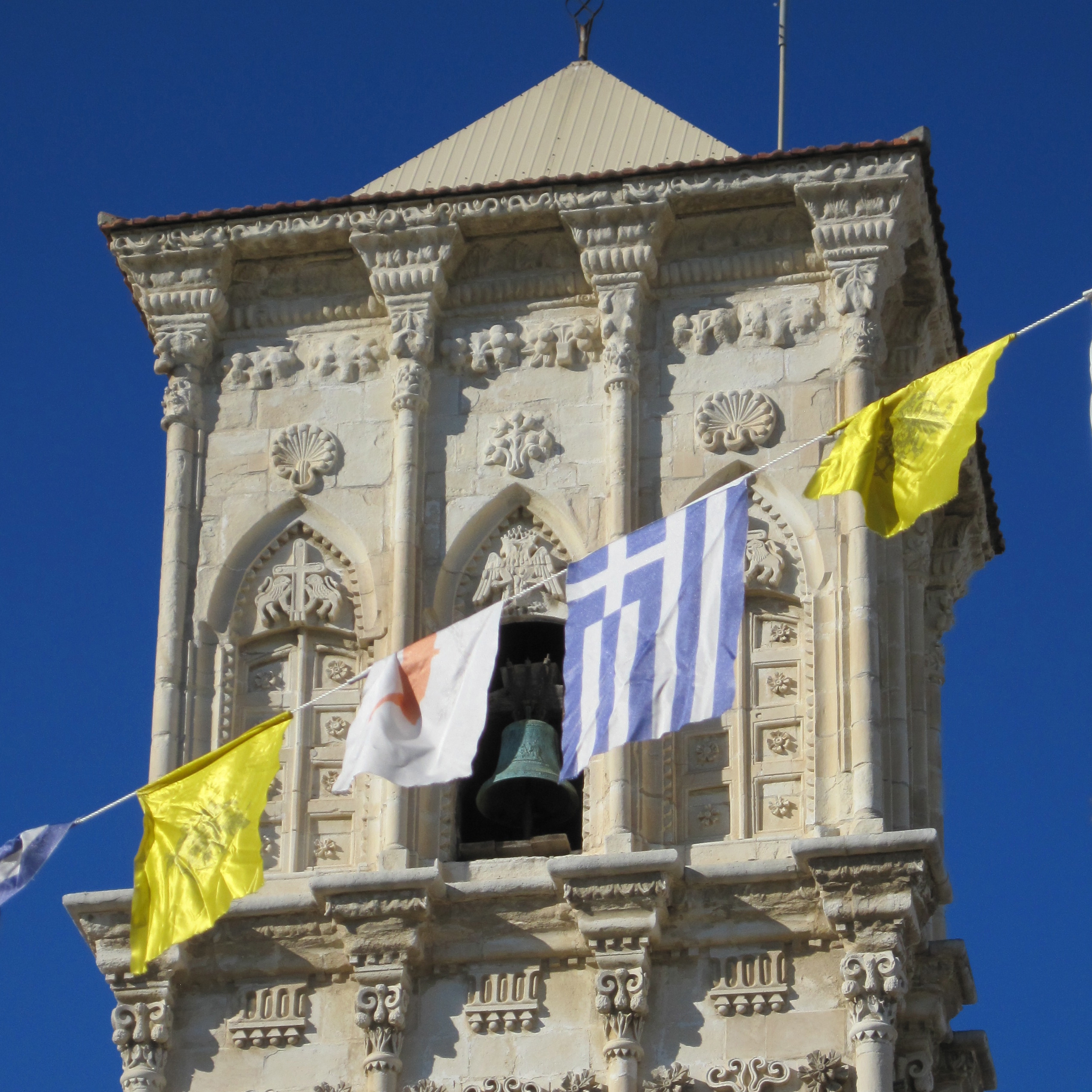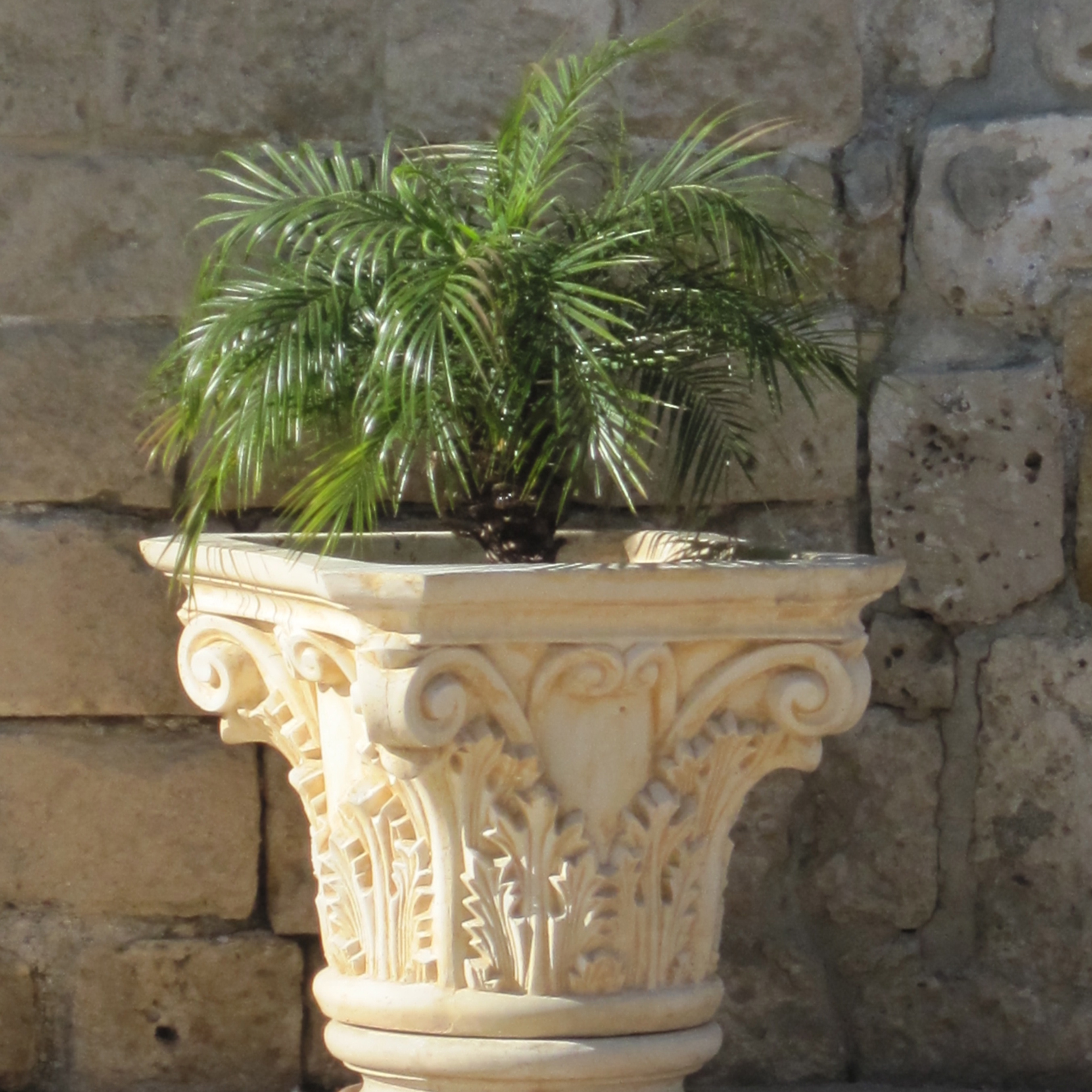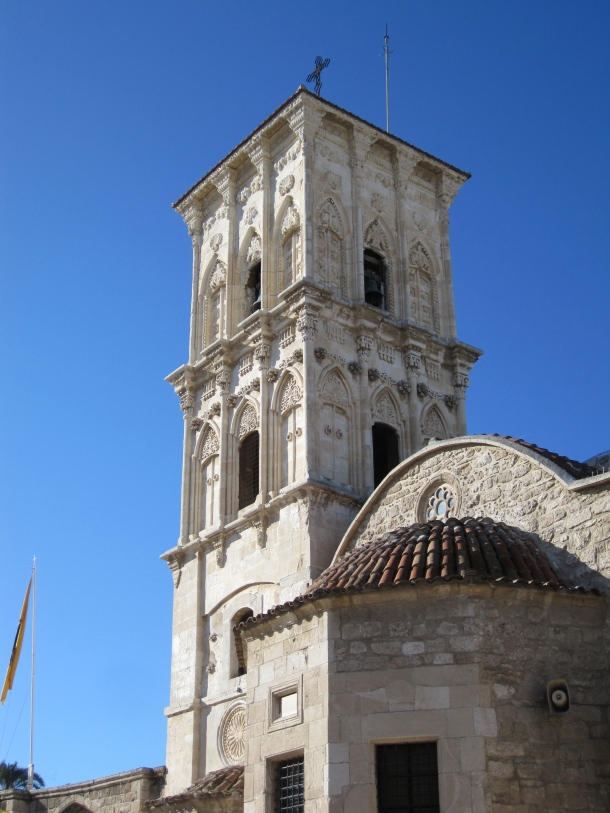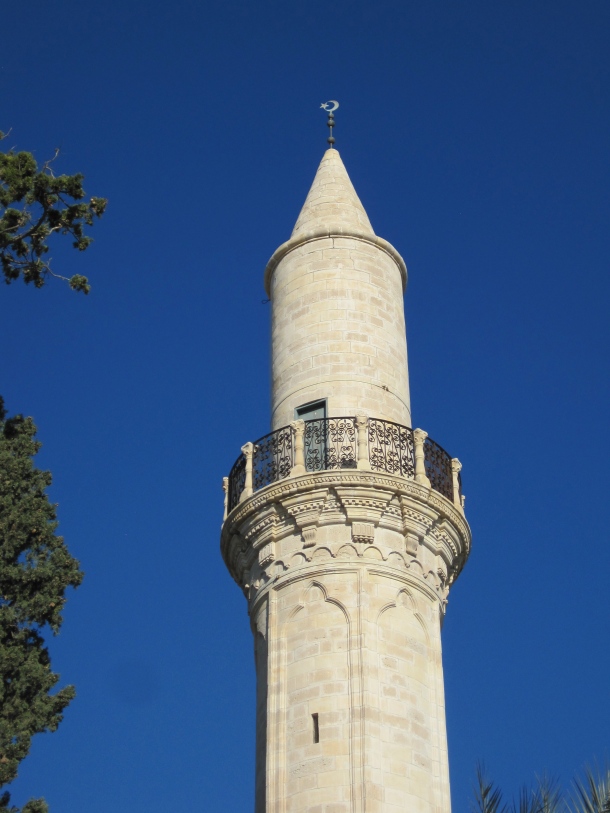




The island nation of Cyprus is at the crossroads of three continents: Europe, Africa, and Asia. It’s the bullseye between Greece, Turkey, Egypt, and the Middle East – not the quietest neighborhood on the planet. The island’s location, its relatively small size, and inability to defend itself against bigger foes has made it a “revolving door” for invaders.
Since the arrival of the Greek Mycenaeans 3500 years ago, wave after wave of conquerers have left their mark. The list of cultures that ruled Cyprus is impressive by any standard: Romans, Phoenicians, Assyrians, English (Richard the Lionheart and the Crusaders), Knights Templar, French Nobility from Jerusalem, Venetians, Ottomans, the British, and most recently, the Turks have made a bid.
Larnaca, on the southeastern coast of Cyprus, has numerous historic buildings that reflect the cultural gumbo these conquerors left behind.
Constructed in the 9th century as a burial site for Lazarus, the Byzantine Church of St. Lazarus has an interesting history. According to Christian scriptures, Lazarus was brought back to life by Jesus; he was later expelled from Judea, and then sailed to Cyprus. Amazingly, he lived in Larnaca for 30 years before dying (again), and being buried here for the final time.
This beautiful minaret is part of the Kebir Mosque, the first Ottoman mosque in Cyprus. In the 13th century, the building started life as a Catholic Church, but Muslims converted it to a mosque in the 18th century. Stone buildings are difficult and expensive to construct, and in a nod to practicality, religious builders had no problems with a bit of creative recycling.
Happy Trails,
James & Terri
Last Updated September 4, 2023


James I love your term ‘cultural gumbo’ !
In Turkey there definitely was a great deal of such mixtures of design and construction. Have you seen that in other spots you have travelled?
Thanks Sue. If you were in Turkey, you probably saw another example – the Hagia Sofia in Istanbul. It went from Cathedral to Mosque. Offsetting that, in Cordoba in southern Spain, La Mezquita de Cordoba (one of my favorite buildings in Spain) went from Mosque to Cathedral. Malta has lots of architectural variety as well, and for the same reason as Cyprus. Its small size and strategic location make it a tasty morsel for invaders – most notably the Knights Templar. ~James
Absolutely James. Throughout Turkey many of the ruins one can see where the Romans left off…like some collaborative building effort…well not really collaborative was it? 🙂
I am looking forward to this. I went to Cyprus in 1998 but went there with blinkers on and saw nothing but beaches and bars!
We were in Larnaca in January Andrew, and the beach was quiet. But, the high rise condos, fish and chips shops, and pubs on the promenade showed that it had the potential for high season partying. It really is an interesting little island, and if you get a chance to return, I’m sure that you’d enjoy it. ~James
I ought to go back, I feel guilty about my lack of appreciation for the place – similarly Crete and Malta!
“Cultural gumbo”… love that! Great post, as usual. 🙂
Thanks Kelly. I suspect that most of these small Mediterranean islands have similarities. For centuries, the Med has been the sea highway for imperialists. We saw it in Malta as well. ~James
Yes yes yes! We go to Cypress for 2 months early April, so very much looking forward to you series. Thanks for this little tidbit.
An old school chum of Don’s offered us the use of their villa on the Larnaca side.
Alison, I’m sure that you both will enjoy Cyprus. The island is relatively small, and there is a network of inexpensive buses that will take you all over. The people we encountered were pleasant and helpful. We’ll look forward to your posts. ~James
Looks very interesting! Looking forward to more.
Thanks Pam. We really enjoyed our time in Cyprus, and it was an example of staying flexible while traveling. We were on our way from Athens to Jordan, looked at the map and said, “We go right by Cyprus, why not stop?” ~James
That’s my kind of trip! We always have a plan A, B, and C – just in case.
Love the shots, especially the one of the blue and white robes. Great graphics. Thanks, too, for including some of the history of Lazarus. What a great trip this must have been.
Thanks Rusha. The vestments of the Archbishop and his entourage really were something to see. The Eastern Orthodox and Catholic Churches are sister organizations, but they have a very different approach to their religious ceremonies. And actually, this is the Archbishop of all of Cyprus, so it was a big deal. ~James
Your pictures are gorgeous! And thanks for your tidbits of history. 🙂
Thanks Cathy. Cyprus isn’t the easiest or most popular places to visit, but we’re glad that we did. If you get in the neighborhood, check it out. ~James
That’s so funny – it never occurred to me that Lazarus died again. 🙂 What a beautiful place to be laid to rest.
By European standards this cathedral was quite small. But what it lacked in size, it made up for in charm. And after a lifetime of hearing about famous Christians, it’s always interesting to visit a location that involved the actual person, instead of the idea. ~James
Perfect arm chair travel today. The beautiful blue skies – the architecture – everything looks warm and wonderful. V.
Thanks Virginia. The blue skies were a welcome sight. The tourist brochure said that that Cyprus has 340 days of sunshine a year, and on the day we arrived, the rain was pelting down. But the next day was a beaut. ~James
I’ve never made it to Cyprus, James. But I certainly saw the mix of cultures on other Mediterranean Islands. I’ve always found the concept of religions building on the sites of earlier religions fascinating. It’s like they want to capture the mojo of the place. Or maybe its a from of erasure. Early Christians wanted to capture the pagans who worshipped at the sites. Adopting their holidays as Christian holidays was another approach. Anyway, I am looking forward to your and Terri’s posts on Cyprus. –Curt
I agree with every one of your points Curt. This takes me back to the Pleistocene when I read Michener’s book “The Source.” (I loved that book!) In addition, there was a fair amount of good ol’ practicality. If you’re trying to encourage the pagans to try a new god, why not have them walk down the same path, on the same day they’ve been walking all their lives. ~James
Off to Cyprus on Sunday – the photos remind me of what an interesting island it is.
I am so envious! We were there on Epiphany (great celebration) and for the dismantling of the Can & Bottle Christmas Tree. Next week we’ll be posting about the Green Line and would like to include a link to your excellent post NICOSIA INTERNATIONAL AIRPORT—A MOMENT FROZEN IN TIME. Would that be OK? And we also realized that we don’t know your names. So sorry. Do you prefer to remain anonymous? I see that you are now in Serbia. Can’t wait to read more about that. All the best, Terri
Dear Terri,
We’d be honoured for you to link to us. We’re really looking forward to your posts on Cyprus—we had a lovely (almost) three years there. For now we’re sitting on the anonymous fence, but drop us a line: doublewhirler@gmail.com so that we can introduce ourselves properly.
Cheers!
What a wonderful teaser, James. I love how your photos are dominated by blue and cream – very Mediterranean if you ask me! The stone on the minaret has aged so well it looks as though it was quarried only ten or twenty years ago. Incredible to think that Cyprus is one of the few places in the world that remain divided… do they allow any visitors on the other side of the Green Line?
Thanks James. On a clear day, Larnaca is a very photogenic place. And yes, the border to the Turkish side is very open. In fact, it was so open, that I almost wandered into Turkey by mistake. I was wandering around, turning and taking photos in all directions, and almost backed over the border. It might not have been a problem, but I didn’t want any of the hassles they were giving the folks returning to the Greek side. Terri and I had a good laugh about it anyway. ~James
Im excited about this series. I went to Cyprus in April, but the Turkish northern part, and it didn´t impress me.. I am told the southern part is gorgeous, and more like traditional Greece.. hope to go some day.
Thanks for the comment Maria and for dropping by the blog. We didn’t go to the Turkish side, but I can say that the south is very cool. In addition to a Greek feel, a few other cultures are thrown in for variety. Caveat Emptor: go in the off-season. The beaches are beautiful, and I understand that it can be a noisy party place in high season. ~James
Very interesting James, it is just amazing how catholicism was “invaded and changed” by other religious groups…
It’s interesting that one of the appealing aspects of religion is its stability. But even religion can’t totally resist change. Catholicism is very different today than in Medieval Italy, and yet it’s the same religion.
Cyprus was fascinating! A pity, though, that I went there at age 18: too young to truly appreciate it. What did make quite an impression on me was peering through the divide through the middle of Nicosia into the buffer zone beyond. So heart-breaking and powerful to see that stretch of the city, empty since 1979, with broken windows and wrecked cars.
Thanks for the comment Ashleigh and for dropping by the blog. The buffer zone looks just as bleak today as it did when you were there, I’m sure. I was pretty oblivious when I was 18, but I think that the border would have even made an impression on me as well. The truly sad thing about this conflict (like most conflicts) is that it was totally avoidable, and there’s plenty of blame to go around. We sat on a bench about 20 ft from the checkpoint and watched people returning to the Greek side. We saw a few very unhappy shoppers who lost their nice-looking, cheap leather bags. Luckily, no shots fired. ~James
I love how you two put together these series of travels you have done. We would love to pick your brain more about travel to Eastern Europe. It is on our radar screen for 2015.
Thanks LuAnn. E Europe has been a focus for us for the past 3 years or so, and we’ve covered a good deal of it. Send us an email if you have any specific questions on destinations or recommendations. ~James
When we get closer to sitting down and drawing out a plan we definitely will. Thanks! 🙂